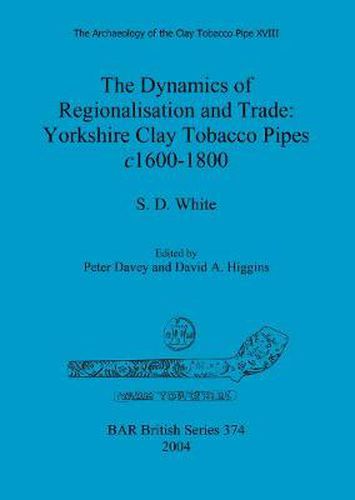Readings Newsletter
Become a Readings Member to make your shopping experience even easier.
Sign in or sign up for free!
You’re not far away from qualifying for FREE standard shipping within Australia
You’ve qualified for FREE standard shipping within Australia
The cart is loading…






This title is printed to order. This book may have been self-published. If so, we cannot guarantee the quality of the content. In the main most books will have gone through the editing process however some may not. We therefore suggest that you be aware of this before ordering this book. If in doubt check either the author or publisher’s details as we are unable to accept any returns unless they are faulty. Please contact us if you have any questions.
As early as the eighteenth century clay tobacco pipes attracted the attention of antiquaries. In more recent years clay tobacco pipes have proved to be one of the most useful artefact types that an archaeologist can recover from a Post-Medieval site.They spanned class and gender being smoked by men and women from all walks for life, and, as such, are seen by many scholars as the ‘ideal type fossil’ for the period 1600 to 1900. 1979 saw the establishment of the research series The archaeology of the clay tobacco pipe , which was seen as a quick means of publishing new archaeological research. Since 1979 seventeen volumes in this series have been published by British Archaeological Reports of Oxford. In this latest volume Susan White has chosen the historic English county of Yorkshire to explore questions such as: whether it is possible to define a style of pipe that is typical of a given study area? Is it possible to define products of individual centres within a given study area? Can trading dynamics of production centres within a given study area be assessed? Can the influence of external production centres be assessed? And if patterns can be identified in, to what extent can they be explained from the historic record? Yorkshire was seen as an original and highly interesting area for research (particularly with regard to regionalisation and trade) as it is large enough for economic variables to come into play, yet small enough for evidence to be fully recorded at a reasonably detailed level. The work comprises ten chapters and a discussion of findings and proposals for future research. The three Appendices feature a list of Yorkshire pipe makers, transcriptions of selected wills, inventories and other documents relating to Yorkshire pipe makers, and summaries of collections.
$9.00 standard shipping within Australia
FREE standard shipping within Australia for orders over $100.00
Express & International shipping calculated at checkout
This title is printed to order. This book may have been self-published. If so, we cannot guarantee the quality of the content. In the main most books will have gone through the editing process however some may not. We therefore suggest that you be aware of this before ordering this book. If in doubt check either the author or publisher’s details as we are unable to accept any returns unless they are faulty. Please contact us if you have any questions.
As early as the eighteenth century clay tobacco pipes attracted the attention of antiquaries. In more recent years clay tobacco pipes have proved to be one of the most useful artefact types that an archaeologist can recover from a Post-Medieval site.They spanned class and gender being smoked by men and women from all walks for life, and, as such, are seen by many scholars as the ‘ideal type fossil’ for the period 1600 to 1900. 1979 saw the establishment of the research series The archaeology of the clay tobacco pipe , which was seen as a quick means of publishing new archaeological research. Since 1979 seventeen volumes in this series have been published by British Archaeological Reports of Oxford. In this latest volume Susan White has chosen the historic English county of Yorkshire to explore questions such as: whether it is possible to define a style of pipe that is typical of a given study area? Is it possible to define products of individual centres within a given study area? Can trading dynamics of production centres within a given study area be assessed? Can the influence of external production centres be assessed? And if patterns can be identified in, to what extent can they be explained from the historic record? Yorkshire was seen as an original and highly interesting area for research (particularly with regard to regionalisation and trade) as it is large enough for economic variables to come into play, yet small enough for evidence to be fully recorded at a reasonably detailed level. The work comprises ten chapters and a discussion of findings and proposals for future research. The three Appendices feature a list of Yorkshire pipe makers, transcriptions of selected wills, inventories and other documents relating to Yorkshire pipe makers, and summaries of collections.